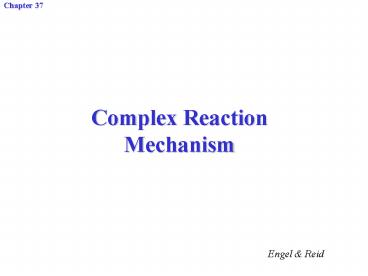Complex Reaction Mechanism - PowerPoint PPT Presentation
Title:
Complex Reaction Mechanism
Description:
37.8 Photochemistry. 37.8.1 Photophysical Processes Figure ... 37.8 Photochemistry Figure 37.15. Figure 37.15. Kinetics description of photo-physical processes. ... – PowerPoint PPT presentation
Number of Views:208
Avg rating:3.0/5.0
Title: Complex Reaction Mechanism
1
Chapter 37
Complex Reaction Mechanism
Engel Reid
2
Figure 37.1
3
Figure 37.2
4
Figure 37.3
5
37.4 Catalysis
Catalysis
6
37.4 Catalysis
- Two assumptions
- SC is small, SC2 can be neglected
- At early stage of the reaction P can be
neglected
7
37.4 Catalysis
Case 1 C0ltltS0
Case 2 C0gtgtS0
8
Figure 37.4a
9
Figure 37.4b
10
Figure 37.6
Michaelis-Menten Enzyme Kinetics
11
37.4 Catalysis
Example Problem 37.1 DeVoe and Kistiakowsky J.
American Chemical Society 83 (1961), 274 studied
the kinetics of CO2 hydration catalyzed by the
enzyme carbonic anhydrase CO2 H2O ?HCO3-1 In
this traction, CO2 is converted to bicarbonate
ion. Bicarbonate is transported in the
bloodstream and converted back to CO2, in the
lungs, a reaction that is also catalyzed by
carbonic anhydrase. The following initial
reaction rates for the hydration reaction were
obtained for an initial enzyme concentration 0f
2.3 nM and temperature of 0.5 oC Determine
Km and k2 for the enzyme at this temperature.
Rate (M s-1) CO2 (mM)
2.78?10-5 1.25
5.00?10-5 2.5
8.33?10-5 5.0
1.67?10-4 20.0
12
(No Transcript)
13
Figure 37.7
14
Figure 37.8a
15
Figure 37.8b
16
Figure 37.9
17
Figure 37.10
18
Figure 37.11
19
Figure 37.12
20
Figure 37.13
21
37.8 Photochemistry37.8.1 Photophysical
Processes Figure 37.14
Figure 37.14 A Joblonski diagram depicting
various photo-physical processes, where S0 is the
ground electronic singlet state, S1 is he first
excited singlet state, and T1is the first excited
triplet state. Radiative processes are indicated
by the straight lines. The nonradiative processes
of intersystem crossing (ISC), internal
conversion (IC), and vibrational relaxation (VR)
are indicated by the wavy lines.
22
37.8 Photochemistry Figure 37.15
Figure 37.15 Kinetics description of
photo-physical processes. Rate constants are
indicated for absorption (ka), fluorescence (kf),
internal conversion (kic), intersystem crossing
from S1 to T1 (ksisc), and phosphorescence (kp)
23
Table 37.1
24
37.8.2 Fluorescence and Fluorescence quenching
Steady-State approximation
Absorption
Internal Conversion
Quenching
Fluorescence
Intersystem crossing
25
Fluorescence life-time, tf
Fluorescence Intensity, If
26
(No Transcript)
27
37.8 Photochemistry
Fluorescence and Fluorescence Quenching
Stern-Volmer plots
Figure 37.16 A Stern-Volmer plot. Intensity of
fluorescence as a function of quencher
concentration is plotted relative to the
intensity in the absence of quencher. The slope
of the line provides a measure of the quenching
rate constant relative to the rate constant for
fluorescence.
28
37.8.3 Measurement of tf
When kf gtgt kic and kf gtgt ksisc
29
Example Problem 37.4
Example Problem 37.4 Thomaz and Stevens (in
Molecular Lumiescence, Lim, 1969)studied the
fluorescence quenching of pyrene in solution.
Using the following information, determine kf and
kq for pyrene in the presence of the quencher
Br6C6.
Br6C6 (M) tf (s)
0.0005 2.6610-7
0.001 1.8710-7
0.002 1.1710-7
0.003 8.5010-8
0.005 5.5110-8
30
slope 3.00109 s-1 kq intercept 1.98106
s-1 kf
31
P37.31) For phenanthrene, the measured lifetime
of the triplet state (tP) is 3.3 s, the
fluorescence quantum yield is 0.12, and the
phosphorescence quantum yield is 0.13 in an
alcohol-ether class at 77 K. Assume that no
quenching and no internal conversion from the
singlet state occurs. Determine kp, kTisc, and
kSisc/kr.
32
Figure 37.17
33
Figure 37.18
34
Example Problem 37.1
35
Example Problem 37.2-1
36
Example Problem 37.2-2

